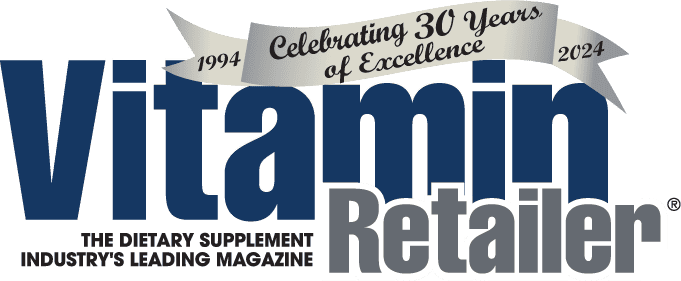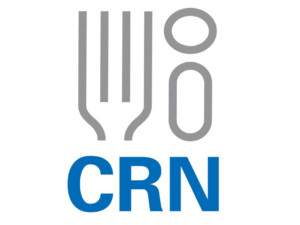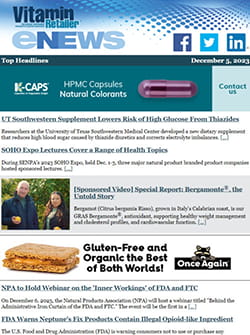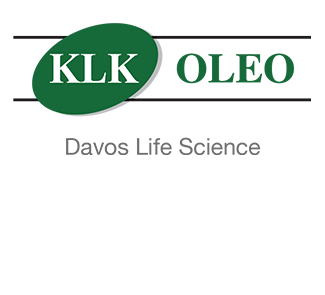Experts weigh in on Washington and the natural products industry.
Participants:
• Jim Emme, CEO, NOW Foods, Bloomingdale, IL, www.nowfoods.com
• Mark A. LeDoux, Chairman and CEO, Natural Alternatives International, Carlsbad, CA, http://nai-online.com
• Dan Lifton, President, Proprietary Branded Ingredients Group, Maypro, Purchase, NY, www.maypro.com
• Steve Mister, President and CEO, Council for Responsible Nutrition (CRN), Washington, D.C., www.crnusa.org
• Marge Roman, Manager, Stay Healthy!, Las Vegas, NV, www.stayhealthylasvegas.com
• Jim Turner, Chair, Citizens for Health, Washington, D.C., www.citizens.org
While investigations and scandals have dominated coverage of anything related to Washington, our panel of natural products industry experts weighs in on media coverage, industry challenges, market dynamics, consumer demand and the future. And they have a few things to say about CBD and kratom, while they’re at it.
VR: What do you feel were the biggest industry issues and challenges of 2018, and why?
Lifton: The year started out with fake negative news about protein powders. Then the FDA (U.S. Food and Drug Administration) issued a guidance document on homeopathics, threatening the entire category. Then there was the FTC (Federal Trade Commision) and New York State’s aggressive posture against the manufacturer of a memory supplement, claiming that the company should have conducted randomized controlled trials and subgroup analysis studies. We also were faced with a multivitamins’ study that looked at the wrong endpoints, misguided proposed anti-supplement legislation in Massachusetts, an aberrant probiotics study and a mischaracterized review of omega-3s for heart health. It’s been a banner year for confusing information, and that’s not even counting the swirl around kratom and CBD products.
LeDoux: The biggest challenges remain the mixed messaging from the media and supposed scientific researchers looking at limited scope of studies to make claims of inefficacy of what most scientists would consider to be essential nutrients for quality of life. Prior activities by attorneys general in our space suggesting inaccurate labeling or product content in herbal products have given rise to a very intelligent response by leading retailers and producers in this industry, namely in the form of the Supplement Safety Compliance Initiative (SSCI).
This effort is being modeled after the GFSI (Grocery equivalent), and is close to launching with benchmarking of audit standards and processes. The nice part about this is that SSCI is a global initiative and is being spearheaded by GNC and Walmart, two of the biggest players in the retail side of our industry. For more information on this exciting development please investigate www.ssciglobal.org and learn how you or your firm can participate.
Emme: One of the ongoing challenges in 2018 has been the uncertainty around trade with escalating tariff threats. Many ingredients are made in China, and trade wars could result in shortages and higher prices. Manufacturers have to think much farther ahead now, and have contingency plans for key ingredients if possible.
Another challenge involves supply chain management for quality. We’re focusing on developing direct sourcing relationships with supply manufacturers around the world so we have more control over quality before the ingredients arrive at our facilities and undergo quality assurance testing.
Turner: The biggest news, yet the least covered story of 2018, are the “guidelines” from the U.S. Department of Agriculture that do away entirely with what the New York Times called the “stigmatized term,” GMO (genetically modified organism). Now Monsanto (now part of Bayer) can call these foods “bioengineered.” The USDA (U.S. Department of Agriculture), in an embarrassingly solicitous pro-industry move, has even come out with smiley-sun-face logos that make GMOs seem fun and natural. I am not sure why the natural products industry has not marched on Washington about this.
VR: Regarding this, what message do you have for brick-and-mortar retailers?
Emme: Regarding trade conflict, stay informed and let your elected officials in Congress know if you are being impacted negatively. For supply chain quality concerns, ask brands detailed questions about how they source ingredients, what their quality specifications are for sourcing, and what kinds of tests they use to check quality on ingredients before and throughout the manufacturing process. Ask if they also do finished product testing, because that’s not a step all manufacturers invest in, but it’s an important one.
Roman: The expansion of large chain stores and the growth of internet “experts.” We try to offer many products the large chain stores don’t carry. We also emphasize service by offering free consultations with a naturopath and special ordering of products.
VR: Way back in our industry Stone Age, people bought products largely based on trust and brand loyalty. Consumers relied on the gold label, the blue bottle, the brands they recognized. Then price wars began and some customers segmented out based on price or convenience. Then, for years, the focus was on benefits, benefits, benefits.
Lately, it appears that customers are increasingly selecting products based on the values of the company behind the products they seek: eco-friendly packaging, sustainably sourced Fair Trade ingredients, socially conscious and engaged brands. Is there a seismic shift from value to values? What does this mean for the supply chain?
Emme: There have always been consumers who have shopped their values, especially in the natural channel, but today that has expanded quite a bit. With consumer ability to access information anytime and anywhere, there is an opportunity for those of us incorporating social and environmental ethics into our company policies to share that information. NOW has always been a value brand that operated with values. Today there is as much, if not more, interest in our values as there is in the affordability of our products. What this means for us regarding the supply chain is that we keep upping our already substantial game in ingredient sourcing. More broadly, companies will have to be able to describe their ingredient sourcing practices to the satisfaction of their customers.
Mister: CRN agrees that there is a seismic shift among consumers from seeking only value to seeking out values in the brands they buy. While price will always be a factor in consumer choices, there are many other components weighing into these buying decisions. Increased interest in transparency, sustainability, and ingredient purity means that supply chains are becoming more and more important to consumers. Sourcing your ingredients in a way that allows you to know the entire pedigree of the ingredients means that suppliers who can provide this information will have an edge. As technology, and in particular block chain, creates more ability to track the entire supply chain, supplement companies who master that ability and are transparent with consumers will have a strong advantage.
Lifton: I think value and values are not mutually exclusive. By supporting brands that do the right thing with ingredients that are sustainably sourced, for example, the environmental inputs are reduced and social benefits are enhanced. And the profits are then clean profits that ascend the entire supply chain.
Turner: The values focus is not a surprise to me at all. Values and a vision for a better and more just world are literally at the roots of the natural products industry and the health-foods movement. With their pocketbooks, consumers have brought the industry around to the values of sustainability, fair trade and integrity on which has always been based.
LeDoux: The presence of Amazon/Whole-Foods in the mix has great appeal to those consumers who believe they know what they want and purchase online for convenience and price. Some of those decisions are only price-driven, some are motivated by convenience, and others motivated by brand-loyalty.
Once DSHEA (The Dietary Health and Foundation Act of 1994) passed into law in 1994, many of the illogical impediments which stood in the way of innovation under the guise of preventing “unapproved food additives” into the food supply, gave way to a more realistic approach to product development.
Over the ensuing 20 years, the industry has expanded, but so have the charlatans who identify loopholes for quick economic gain, and some who are outright criminals resorting to mislabeling products as foods or supplements while knowingly including non-disclosed active pharmaceutical compounds in the products, often leading to serious side effects and even death.
Some consumers are swayed by some of the marketing statements associated with their own internal compassion meters and sense of social justice.
VR: What does this mean for retailers?
Emme: It’s great motivation for retailers to review the corporate practices of the lines they carry so they can convey that information to their customers in the aisles, on their website, and via newsletters and social media.
Roman: I don’t think the shift has happened, but it’s coming. I believe the supply chain is taking notice and becoming more transparent.
VR: In May 2014, British biotech company GW Pharmaceuticals was granted Investigational New Drug (IND) status from the FDA for phase 2/3 clinical trial of Epidiolex, a proprietary cannabinoid composition, for the treatment of Dravet Syndrome. Meanwhile, while the Farm Bill includes an amendment directing the DEA (Drug Enforcement Agency) to remove CBD from its Schedule 1 list, the FDA appears to be allowing these very narrow IND filings to block the emergence of an entire industry within our industry.
The FDA recently said that it is not aware of any evidence that would call into question its current conclusion that cannabidiol products are excluded from the dietary supplement definition under section 201 (ff)(3)(B)(ii) of the TD&C Act. Interested parties may present the agency with any evidence that they think has bearing on this issue.
Does industry have evidence that CBD products were marketed before the IND filing? If so, or if not, what are next steps for industry?
Turner: Regardless of whether there is evidence—not very likely considering the illicit mantle that has been draped on the category by the DEA and the FDA—the FDA is once again pandering to Big Pharma, similar to what it did with red yeast rice and lovastatin. Somewhat similar to what it did with stevia. And now it’s doing it again, but in this case putting a monkey wrench on the tracks of a massive and exciting category that seems poised to go off the rails, unless new legislation is written and passed.
The Senate version of the Farm Bill included an entire amendment that would take industrial hemp off the DEA’s Class I narcotics list and lay the groundwork for the return of widespread hemp growing in the U.S. But the FDA may very well mess this up, at the very least for dietary supplements.
Mister: You can’t deny the great consumer interest in CBD products. However, FDA has been equally clear that, at present, CBD is not a legal dietary ingredient. At this point, CBD has been identified as a controlled substance, and unless Congress enacts the Hemp Farm Act, CBD is not a legal dietary ingredient. Industry has the opportunity to remove some of these barriers to the market by working to enact the Hemp Farm Act and by petitioning for an exemption to section 201 (ff)(3)(B)(ii) of the Food Drug and Cosmetic Act. Companies hoping to bring CBD to the supplement market should be conducting the necessary safety studies to meet their obligations as a new dietary ingredient. CRN’s Board of Directors is closely examining how to assist companies with these hurdles because CRN recognizes the market potential of CBD.
LeDoux: The registration of Epidiolex as a drug under the FDA system earlier this summer has essentially closed the door on commerce in this space for companies wanting to provide CBD to treat related conditions. Notwithstanding those state jurisdictions that permit recreational cannabinoid use in a variety of forms, the likelihood of the FDA changing position on this matter is very low. Given that the FDA has stated it is unaware of any evidence that would call into question its conclusion that cannabidiol products are excluded from the dietary supplement definition, and the paucity of appropriate data that may be shared with the agency to seek to change their minds, it is unlikely to change the situation.
To the best of my knowledge, there is no evidence in existence that properly manufactured or standardized CBD products were marketed prior to the IND filing of GW Pharma. If the industry wants to change the law, that starts with identifying new legislation and committees of jurisdiction in the House and Senate to lobby in the hopes of adopting a new point of view. The likelihood of success in an election year for this endeavor is not good.
VR: What are next steps for retailers whose customers are clamoring for CBD/hemp products?
Roman: We have carried CBD for almost four years, and only had one brand. That is rapidly changing. I have had to become educated on CBD/hemp, including where it is grown and how it is extracted. The choice of products in my store is huge because we are a large recreational cannabis state. This makes my job harder and the research more important. Quality and transparency are my deciding factors.
VR: Recently, the New York Times published an article entitled, “Vitamin D, the Sunshine Supplement, Has Shadowy Money Behind It.” The piece masquerades as investigative journalism but is actually an opinion piece built on an ad hominem attack against the country’s leading vitamin D researcher, Dr. Michael Holick. All major researchers get funding and support; that’s how they can do the research.
But what is the real takeaway here? Just another attempt to drag a vital vitamin through the mud, or just mass media journos looking under rocks?
Lifton: It appears that that article was an agenda in search of a story. Academic research requires grants and funding support in order to continue. Regardless of the specifics of the reporters’ assertions, the real bottom line here is that vitamin D deficiency is a worldwide problem, made worse by today’s obsession with sun-blocks, poor diets and extreme sun-avoidance. The body of vitamin D science is vast and compelling, and is frankly bulletproof. No presumed expose can change that fact.
Mister: One of the major takeaways from the New York Times article is the piece’s disregard for the importance of vitamin D as a shortfall nutrient of public health concern in the government’s Dietary Guidelines for Americans. While the article focuses on Dr. Holick’s work with testing providers and other stakeholder groups, the article ignores the fact that a majority of Americans, 94 percent, fail to achieve their government-recommended intakes of vitamin D. Focusing on the consulting activity of one individual does not erase the well-established benefits of vitamin D and could lead many people to dismiss those health benefits.
Emme: The New York Times has a long history of cherry picking science to criticize the industry and the products it produces and sells. And the consumers who use supplements generally ignore them. The media reports each new study as definitive, when it’s a body of science that should be evaluated to put new research into perspective. The growing body of science supporting safe and effective use of supplements has won the support of many health care practitioners, and the steadily growing number of consumers makes it clear that their own experience has convinced them that supplements are part of a healthy lifestyle. LeDoux: This article demonstrates the clear bias of the New York Times against the industry. Pharmaceutical research involving investigational new drugs requires various levels of scholastic and scientific enquiry. Who ultimately pays those folks to do that work? Pharmaceutical companies engage third party research firms to quarterback research into all sorts of work to help benefit their patent portfolio, and to expand their presence in the consumer and medical marketplace.
To suggest that somehow research on something as essential as vitamin D is somehow biased because industry contributed to the expenses of running clinical investigations is almost laughable. Data that is obtained by clinical research, particularly in double blind placebo controlled studies, is rigorously evaluated by statistical analysis, reports are assembled and vetted with leading experts and contributors to the area of germane science, and evaluations are submitted for peer reviewed medical or scientific journals prior to ever being published. To suggest some nefarious intent of the producers of raw materials associated with vitamin D production in promoting bona fide research is actually somewhat ludicrous.
Turner: The takeaway is that if there is no smoke, mass media will often light a fire. It’s a case of damned if you do, damned if you don’t. Vitamin research has always struggled because researchers have had trouble getting sufficient funding for studies of non-patentable nutrients. Upwards of $10 billion passes through the hands of Big Pharma to scientists and their institutions for drug research, and nobody cares. But if a scientist receives $10 in support of vitamin research, then it’s a scandal. It’s a non-story, at best, and, at worst, is a shameful attack on a brilliant man.
Roman: I feel some are just simply against supplements, and that may never change. I tend to take those articles with a grain of salt. Also, over the years I have come to understand the ‘slants’ certain media articles present.
VR: Kratom. The newest David vs. Goliath story? Certainly the FDA is attempting to pressure the DEA to place kratom on the Schedule 1 drug list. The FDA claims 44 deaths have been associated with the use of kratom worldwide over the last nine years. Meanwhile, the American Kratom Association rejects this assertion, noting that in all cases cited by the FDA, other circumstances, such as adulterated additives, were the actual cause of the deaths. This group is calling on the FDA to take action against manufacturers of adulterated products. Ephedra part 2, or something else?
Roman: I couldn’t decide on kratom for many years. And after two years I felt was reputable, [one that] disclosed the source of their product and stood behind it.
Like many things, kratom can be abused but, if used properly, I have seen customers get great results. I have also seen many use it to get off the opioid drugs that have become an issue for them. It very well may go the way of ephedra, but I hope not. I think the good outweighs the bad.
LeDoux: The problem with this whole space is the lack of standardization of the product in question and the applications for use. We are all aware of the perils associated with opioid abuse, but kratom taken as a popular means to withdraw from opioid addiction is perilous unless the product is quantified, the use is monitored and side effects are evaluated and presented for consideration.
In essence, it is my opinion that kratom producers should think about working collectively to create their own IND and submit it for a standardized compound that could withstand the rigorous evaluation required of investigational new drugs. I do not believe the FDA or DEA is going to relent on this one.
The real issue as I see it also rests with the apparent paralysis of the agencies on this issue. If these products are widely available and are considered dangerous, why are these items not being seized by inspectors, or why isn’t the DOJ (Department of Justice) assisting FDA and HHS (U.S. Department of Health and Human Services) with cleaning up the market? If it is resource constraint, how much is needed, and if secured when will the problem be fixed?
Mister: Until a kratom manufacturer demonstrates to FDA that the ingredient is reasonably expected to be safe, FDA correctly objects that kratom is an NDI (new dietary ingredient) without a notification. It’s disappointing, although not surprising, that retailers who are not exactly associated with healthcare solutions, would be marketing what are essentially illegal drugs. FDA should be enforcing the law more aggressively.
Turner: The Ephedra Education Council jumped off the ephedra train before it crashed. Ephedra became a scapegoat due to bad decisions by a handful of marketers and manufacturers and due to the success of an army of private plaintiff attorneys and an oft-times gullible media.
Kratom should not be run out on the rails just because there are events allegedly, although not conclusively, linked to it. While it doesn’t help that it has been marginalized since it entered the market—sold at gas stations and such—I am not sure if that is the fault of the first wave of marketers or due to the hostile regulatory posture from the FDA.
VR: Now in terms of economic adulteration, what strides has the industry made in 2018 to tackle the grey-market sale of dietary supplements illegally spiked with selective androgen receptor modulators (SARMs)?
Mister: CRN is at the forefront of addressing selective androgen receptor modulators (SARMs). Taking a two pronged approach, CRN is looking at both the supply and demand aspects of SARMs. On the supply side, CRN continues to work with partners like USADA (U.S. Anti-Doping Agency) to develop legislation that will limit the supply of this drug that is often falsely labeled as a dietary supplement.
From the demand side, CRN launched a consumer education initiative to help consumers, particularly in the bodybuilding and fitness communities, understand the risk of SARMs and avoid products that may contain this dangerous class of ingredients.
To help raise awareness, CRN created a #SARMsCanHarm toolkit for fitness organizations that includes customizable flyers, newsletter material, and social media content highlighting educational information on SARMs.
LeDoux: Industry has done a good job educating folks about the perils associated with undisclosed components, but it needs more enforcement by federal and state agencies to help clean up this problem. Likewise, U.S. Customs enforcement needs to take place on a more wide scale for what is often blatantly mislabeled or adulterated goods coming from overseas.
VR: What guidance or tips do you have for retailers in identifying these products before they ever get on their shelves and in customers’ hands?
Emme: Retailers can insure they are selling quality, legal products by researching brands, asking questions and choosing the brands they offer for sale with care. Roman: As a retailer, I have to research new vendors from source to bottle to shelf.
VR: On the positive side, what are the most exciting developments in technology, processing, extraction or delivery you have seen in 2018?
Lifton: Fermentation, culturing and bioavailability technologies have grown by leaps and bounds, not only in 2018 but over the last 10 years. That’s why our AHCC patented mushroom extract has received industry awards for being the most-researched specialty immune supplement. Or Oligonol, which has earned technology awards for its low-molecular-weight polyphenol ingredient. Or our L-92, a revolutionary sterilized human acidophilus strain geared for beauty from within, which has also gotten awards. Across the industry, leading manufacturers and brands are recognizing that a product is only as good as how good it works. Is it bioavailable? Is it made for maximum absorption? Is it backed by human clinical research? Is it maximally effective? We continually strive for a “yes” on all of those critical questions.
Emme: Methods for ingredient testing continue to be more accurate and available for use by reliable and capable laboratories. The trends toward personalized nutrition show the possibility of great promise in the future.
VR: What other thoughts do you have for industry? For retailers?
Emme: We as an industry need to continue to build trust with consumers of natural products, and to advocate through the trade organizations to encourage the FDA to enforce the regulations that are currently in place. There continues to be counterfeit and substandard products in the marketplace, activities that can pose risk to consumers.
Retailers continue to be the most important information source for consumers, and also are the key generators of new products ideas due to their direct contact with the consumers who shop at their stores.
VR: What are your industry predictions for 2019?
LeDoux: Consolidations in the industry will continue and larger companies in the food and pharmaceutical companies will be looking at taking significant positions as they seek to build market share.
Demographic shifts will impact product preferences along with pricing power, but there will be greater emphasis on private and controlled label products competing against nationally advertised brands.
The government—both federal and state—will be more involved in policing online commercial and advertising activity, and if they are not, then expect the plaintiff’s bar to have a field day cleaning up the industry in terms of the myriad of products illegally labeled or blatantly selling goods with illegal content on various websites.
There will be a concerted effort to involve the USDA more in our space, and perhaps initiate a carve-out from HHS if the FDA is not more responsive to Capitol Hill in enforcement of the regulations.
VR: What can retailers look forward to, or focus on, in 2019?
Emme: Retailers will likely develop new ways to serve consumers, particularly with value added services. We are already seeing this from some retailers in the form of curbside order pickups. Continued relationship focus with consumers will still be a key to success. Many retailers already excel at this tenet. VR












